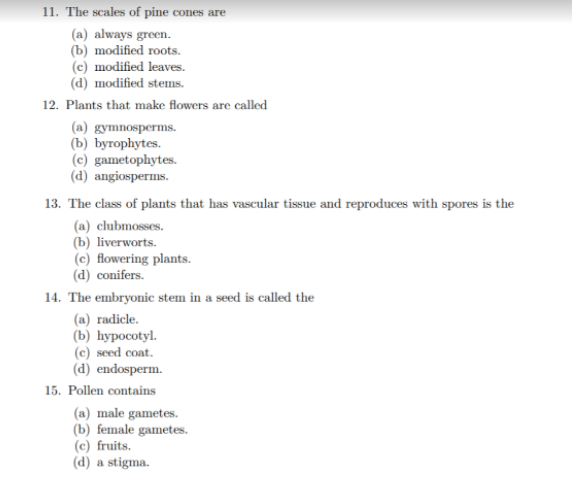11. The scales of pine cones are (a) always green. (b) modified roots. (c) modified leaves. (d) modified stems. 12. Plants that make flowers are called (a) gymnosperms. (b) bуторhytes. (c) gametophytes. (d) angiosperms. 13. The class of plants that has vascular tissue and reproduces with spores is the (a) clubmosses. (b) liverworts. (c) flowering plants. (d) conifers.
11. The scales of pine cones are (a) always green. (b) modified roots. (c) modified leaves. (d) modified stems. 12. Plants that make flowers are called (a) gymnosperms. (b) bуторhytes. (c) gametophytes. (d) angiosperms. 13. The class of plants that has vascular tissue and reproduces with spores is the (a) clubmosses. (b) liverworts. (c) flowering plants. (d) conifers.
Biology: The Dynamic Science (MindTap Course List)
4th Edition
ISBN:9781305389892
Author:Peter J. Russell, Paul E. Hertz, Beverly McMillan
Publisher:Peter J. Russell, Paul E. Hertz, Beverly McMillan
Chapter29: Seed Plants
Section: Chapter Questions
Problem 10TYK: Adaptations that correlate with the adaptive success of angiosperms include: a. seeds borne on...
Related questions
Concept explainers
Question
100%

Transcribed Image Text:11. The scales of pine cones are
(a) always green.
(b) modified roots.
(c) modified leaves.
(d) modified stems.
12. Plants that make flowers are called
(a) gymnosperms.
(b) byrophytes.
(c) gametophytes.
(d) angiosperms.
13. The class of plants that has vascular tissue and reproduces with spores is the
(a) clubmosses.
(b) liverworts.
(c) flowering plants.
(d) conifers.
14. The embryonic stem in a seed is called the
(a) radicle.
(b) hypocotyl.
(c) seed cont.
(d) endosperm.
15. Pollen contains
(a) male gametes.
(b) female gametes.
(c) fruits.
(d) a stigma.
Expert Solution
This question has been solved!
Explore an expertly crafted, step-by-step solution for a thorough understanding of key concepts.
This is a popular solution!
Trending now
This is a popular solution!
Step by step
Solved in 2 steps with 3 images

Follow-up Questions
Read through expert solutions to related follow-up questions below.
Follow-up Question

Transcribed Image Text:6. Marine plants
(a) have always been the dominant organisms of the oceans.
(b) evolved after land plants.
(c) are restricted to the water closer to the air, so they can get sufficient light for photosynthesis.
(d) do not need to photosynthesize.

Transcribed Image Text:14. The embryonic stem in a seed is called the
(a) radicle.
(b) hypocotyl.
(c) seed coat.
(d) endosperm.
15. Pollen contains
(a) male gametes.
(b) female gametes.
(c) fruits.
(d) a stigma.
Solution
Knowledge Booster
Learn more about
Need a deep-dive on the concept behind this application? Look no further. Learn more about this topic, biology and related others by exploring similar questions and additional content below.Recommended textbooks for you

Biology: The Dynamic Science (MindTap Course List)
Biology
ISBN:
9781305389892
Author:
Peter J. Russell, Paul E. Hertz, Beverly McMillan
Publisher:
Cengage Learning

Concepts of Biology
Biology
ISBN:
9781938168116
Author:
Samantha Fowler, Rebecca Roush, James Wise
Publisher:
OpenStax College

Biology: The Dynamic Science (MindTap Course List)
Biology
ISBN:
9781305389892
Author:
Peter J. Russell, Paul E. Hertz, Beverly McMillan
Publisher:
Cengage Learning

Concepts of Biology
Biology
ISBN:
9781938168116
Author:
Samantha Fowler, Rebecca Roush, James Wise
Publisher:
OpenStax College